Study of the Mechanical Performance of Grid-Reinforced Concrete Beams with Basalt Fiber-Reinforced Polymers
Abstract
1. Introduction
2. Experimental Section
2.1. Specimen Design
2.2. Material Properties
2.3. Test Setup and Instrumentation
3. Test Results
3.1. Visual Observation and Failure Modes
3.1.1. Bending Performance Test
3.1.2. Shear Performance Testing
3.2. Load-Displacement Curves
3.2.1. Bending Performance Curves
3.2.2. Shear Performance Curves
3.2.3. Discussion of Bending Performance
3.2.4. Discussion of Bending Performance
3.3. Design Methods of Load-Bearing Capacity
3.3.1. Design Methods of Flexural Bearing Capacity
3.3.2. Design Methods for Shear-Bearing Capacity
3.3.3. Design Method for BFRP Grid-Reinforced Concrete Beams
4. Conclusions
Author Contributions
Funding
Data Availability Statement
Conflicts of Interest
References
- Ahmed, A.; Guo, S.; Zhang, Z.; Shi, C.; Zhu, D. A review on durability of fiber reinforced polymer (FRP) bars reinforced seawater sea sand concrete. Constr. Build. Mater. 2020, 256, 119484. [Google Scholar] [CrossRef]
- Liu, X.; Zheng, Y.; Fang, Q.; Zhou, C.; Yang, Y.; Xiang, H.; Yan, H. Anti-collision performance of RC columns strengthened with a composite of FRP grid and UHPC. Structures 2022, 43, 1682–1691. [Google Scholar] [CrossRef]
- Nepomuceno, E.; Sena-Cruz, J.; Correia, L.; D’Antino, T. Review on the bond behavior and durability of FRP bars to concrete. Constr. Build. Mater. 2021, 287, 123042. [Google Scholar] [CrossRef]
- Hollaway, L.C. A review of the present and future utilisation of FRP composites in the civil infrastructure with reference to their important in-service properties. Constr. Build. Mater. 2010, 24, 2419–2445. [Google Scholar] [CrossRef]
- Zhao, X.; Zhang, L. State-of-the-art review on FRP strengthened steel structures. Eng. Struct. 2007, 29, 1808–1823. [Google Scholar] [CrossRef]
- Mugahed Amran, Y.H.; Alyousef, R.; Rashid, R.S.M.; Alabduljabbar, H.; Hung, C. Properties and applications of FRP in strengthening RC structures: A review. Structures 2018, 16, 208–238. [Google Scholar] [CrossRef]
- Rosa, I.C.; Firmo, J.P.; Correia, J.R.; Mazzuca, P. Influence of elevated temperatures on the bond behaviour of GFRP bars to concrete–pull-out tests. In Proceedings of the IABSE Symposium: Towards a Resilient Built Environment Risk and Asset Management, Guimarães, Portugal, 27–29 March 2019. [Google Scholar]
- Rosa, I.C.; Firmo, J.P.; Correia, J.R.; Barros, J.A.O. Bond behaviour of sand coated GFRP bars to concrete at elevated temperature–Definition of bond vs. slip relations. Composites Part B Eng. 2019, 160, 329–340. [Google Scholar] [CrossRef]
- Mazzuca, P.; Firmo, J.P.; Correia, J.R.; Castilho, E. Influence of elevated temperatures on the mechanical properties of glass fibre reinforced polymer laminates produced by vacuum infusion. Constr. Build. Mater. 2022, 345, 128340. [Google Scholar] [CrossRef]
- Zeng, J.; Zeng, W.; Ye, Y.; Liao, J.; Zhuge, Y.; Fan, T. Flexural behavior of FRP grid reinforced ultra-high-performance concrete composite plates with different types of fibers. Eng. Struct. 2022, 272, 115020. [Google Scholar] [CrossRef]
- Pan, B.; Liu, F.; Zhuge, Y.; Zeng, J.; Liao, J. ECCs/UHPFRCCs with and without FRP reinforcement for structural strengthening/repairing: A state-of-the-art review. Constr. Build. Mater. 2022, 316, 125824. [Google Scholar] [CrossRef]
- Lu, Z.; Su, L.; Xian, G.; Lu, B.; Xie, J. Durability study of concrete-covered basalt fiber-reinforced polymer (BFRP) bars in marine environment. Compos. Struct. 2020, 234, 111650. [Google Scholar] [CrossRef]
- Lu, Z.; Li, W.; Zeng, X.; Pan, Y. Durability of BFRP bars and BFRP reinforced seawater sea-sand concrete beams immersed in water and simulated seawater. Constr. Build. Mater. 2023, 363, 129845. [Google Scholar] [CrossRef]
- Zhang, B.; Zhu, H.; Chen, J. Bond durability between BFRP bars and seawater coral aggregate concrete under seawater corrosion environments. Constr. Build. Mater. 2023, 379, 131274. [Google Scholar] [CrossRef]
- Li, S.; Zhu, D.; Guo, S.; Xi, H.; Rahman, M.Z.; Yi, Y.; Fu, B.; Shi, C. Static and dynamic tensile behaviors of BFRP bars embedded in seawater sea sand concrete under marine environment. Composites Part B Eng. 2022, 242, 110051. [Google Scholar] [CrossRef]
- Xu, X.; Rawat, P.; Shi, Y.; Zhu, D. Tensile mechanical properties of basalt fiber reinforced polymer tendons at low to intermediate strain rates. Composites Part B Eng. 2019, 177, 107442. [Google Scholar] [CrossRef]
- Chen, W.; Hao, H.; Jong, M.; Cui, J.; Shi, Y.; Chen, L.; Pham, T.M. Quasi-static and dynamic tensile properties of basalt fibre reinforced polymer. Composites Part B Eng. 2017, 125, 123–133. [Google Scholar] [CrossRef]
- Lopresto, V.; Leone, C.; De Iorio, I. Mechanical characterisation of basalt fibre reinforced plastic. Composites Part B Eng. 2011, 42, 717–723. [Google Scholar] [CrossRef]
- Ma, G.; Huang, Y.; Aslani, F.; Kim, T. Tensile and bonding behaviours of hybridized BFRP–steel bars as concrete reinforcement. Constr. Build. Mater. 2019, 201, 62–71. [Google Scholar] [CrossRef]
- Shan, Z.; Liang, K.; Chen, L. Bond behavior of helically wound FRP bars with different surface characteristics in fiber-reinforced concrete. J. Build. Eng. 2023, 65, 105504. [Google Scholar] [CrossRef]
- Liang, K.; Chen, L.; Shan, Z.; Su, R.K.L. Experimental and theoretical study on bond behavior of helically wound FRP bars with different rib geometry embedded in ultra-high-performance concrete. Eng. Struct. 2023, 281, 115769. [Google Scholar] [CrossRef]
- Chen, L.; Liang, K.; Shan, Z. Experimental and theoretical studies on bond behavior between concrete and FRP bars with different surface conditions. Compos. Struct. 2023, 309, 116721. [Google Scholar] [CrossRef]
- Feng, G.; Zhu, D.; Guo, S.; Rahman, M.Z.; Jin, Z.; Shi, C. A review on mechanical properties and deterioration mechanisms of FRP bars under severe environmental and loading conditions. Cem. Concr. Compos. 2022, 134, 104758. [Google Scholar] [CrossRef]
- Zhang, K.; Zhang, Q.; Xiao, J. Durability of FRP bars and FRP bar reinforced seawater sea sand concrete structures in marine environments. Constr. Build. Mater. 2022, 350, 128898. [Google Scholar] [CrossRef]
- Lu, Z.; Xian, G.; Li, H. Effects of exposure to elevated temperatures and subsequent immersion in water or alkaline solution on the mechanical properties of pultruded BFRP plates. Composites Part B Eng. 2015, 77, 421–430. [Google Scholar] [CrossRef]
- Lu, Z.; Tan, S.; Huang, P.; Lei, Z.; Liu, F.; Xie, J. Durability of cement mortar-covered BFRP bars in simulated seawater environment. Constr. Build. Mater. 2020, 234, 117803. [Google Scholar] [CrossRef]
- Lu, Z.; Li, Y.; Xie, J. Durability of BFRP bars wrapped in seawater sea sand concrete. Compos. Struct. 2021, 255, 112935. [Google Scholar] [CrossRef]
- Li, S.; Guo, S.; Yao, Y.; Jin, Z.; Shi, C.; Zhu, D. The effects of aging in seawater and SWSSC and strain rate on the tensile performance of GFRP/BFRP composites: A critical review. Constr. Build. Mater. 2021, 282, 122534. [Google Scholar] [CrossRef]
- Dong, Z.; Wu, G.; Zhu, H.; Zhao, X.; Wei, Y.; Qian, H. Flexural behavior of seawater sea-sand coral concrete–UHPC composite beams reinforced with BFRP bars. Constr. Build. Mater. 2020, 265, 120279. [Google Scholar] [CrossRef]
- Hua, Y.; Yin, S.; Peng, Z. Crack development and calculation method for the flexural cracks in BFRP reinforced seawater sea-sand concrete (SWSSC) beams. Constr. Build. Mater. 2020, 255, 119328. [Google Scholar] [CrossRef]
- Abed, F.; Alhafiz, A.R. Effect of basalt fibers on the flexural behavior of concrete beams reinforced with BFRP bars. Compos. Struct. 2019, 215, 23–34. [Google Scholar] [CrossRef]
- Elgabbas, F.; Ahmed, E.A.; Benmokrane, B. Physical and mechanical characteristics of new basalt-FRP bars for reinforcing concrete structures. Constr. Build. Mater. 2015, 95, 623–635. [Google Scholar] [CrossRef]
- Jia, M.; Xiao, X.; Lu, X.; Feng, G.; Qian, K. Influence of stacking sequence of basalt-fiber grilles on mechanical properties for textile-reinforced concrete and theoretical prediction. Text. Res. J. 2020, 90, 1931–1947. [Google Scholar] [CrossRef]
- Jia, M.; Xie, W.; Yu, K.; Qian, K. A Comparative Study of the Mechanical Properties of Basalt Fiber and Basalt Grille Reinforced Concrete Composites and Theoretical Prediction. J. Nat. Fibers 2022, 19, 5862–5879. [Google Scholar] [CrossRef]
- Ye, Y.; Smith, S.T.; Zeng, J.; Zhuge, Y.; Quach, W. Novel ultra-high-performance concrete composite plates reinforced with FRP grid: Development and mechanical behaviour. Compos. Struct. 2021, 269, 114033. [Google Scholar] [CrossRef]
- GB/T 50152-2012; Standard for Test Method of Concrete Structures. National Standards of the People’s Republic of China: Beijing, China, 2012.
- ACI440.1R-06; Committee, A.C.I.A. Guide for the Design and Construction of Concrete Reinforced with FRP Bars. American Concrete Institute: Indianapolis, IN, USA, 2006.

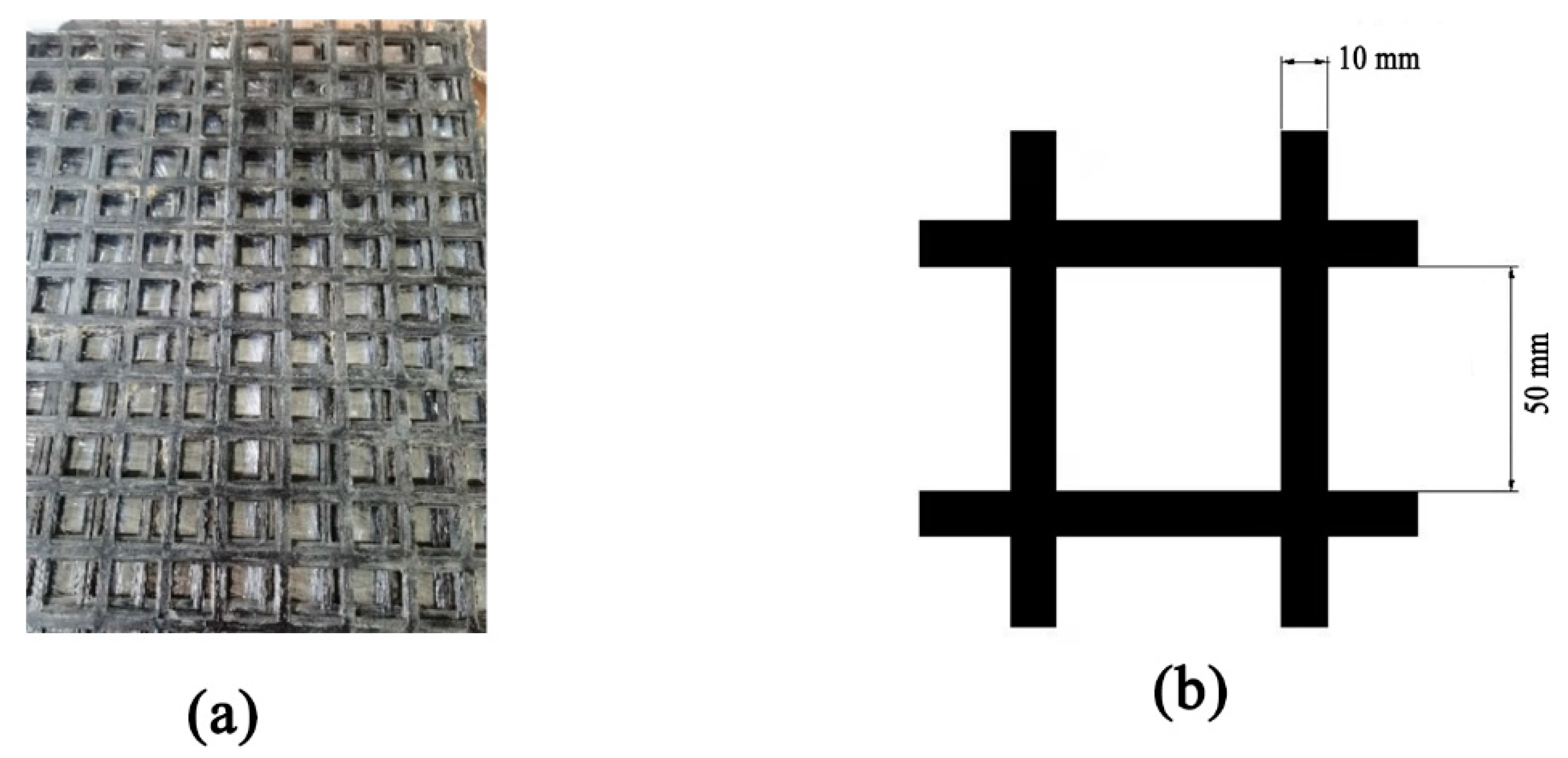
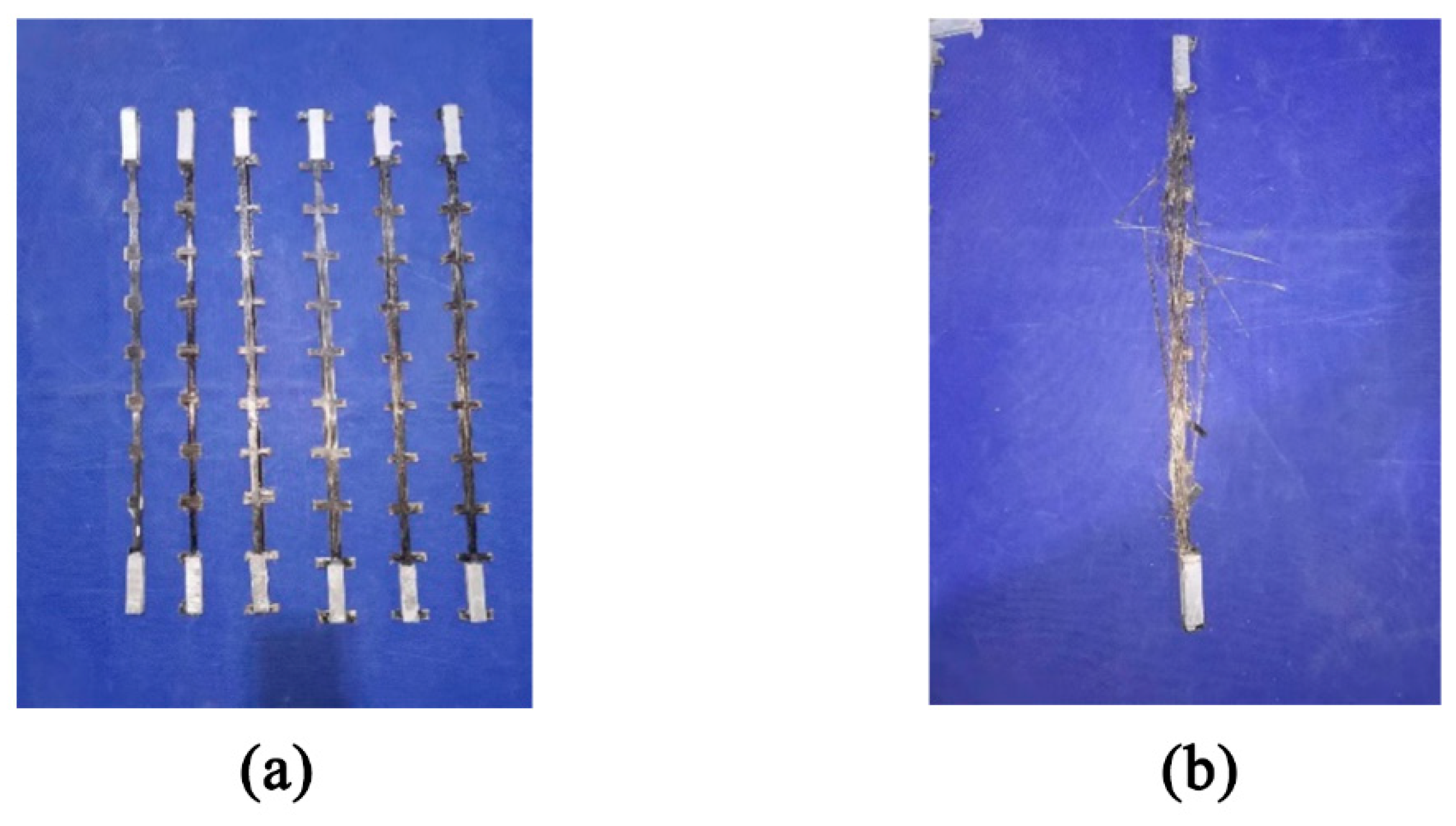
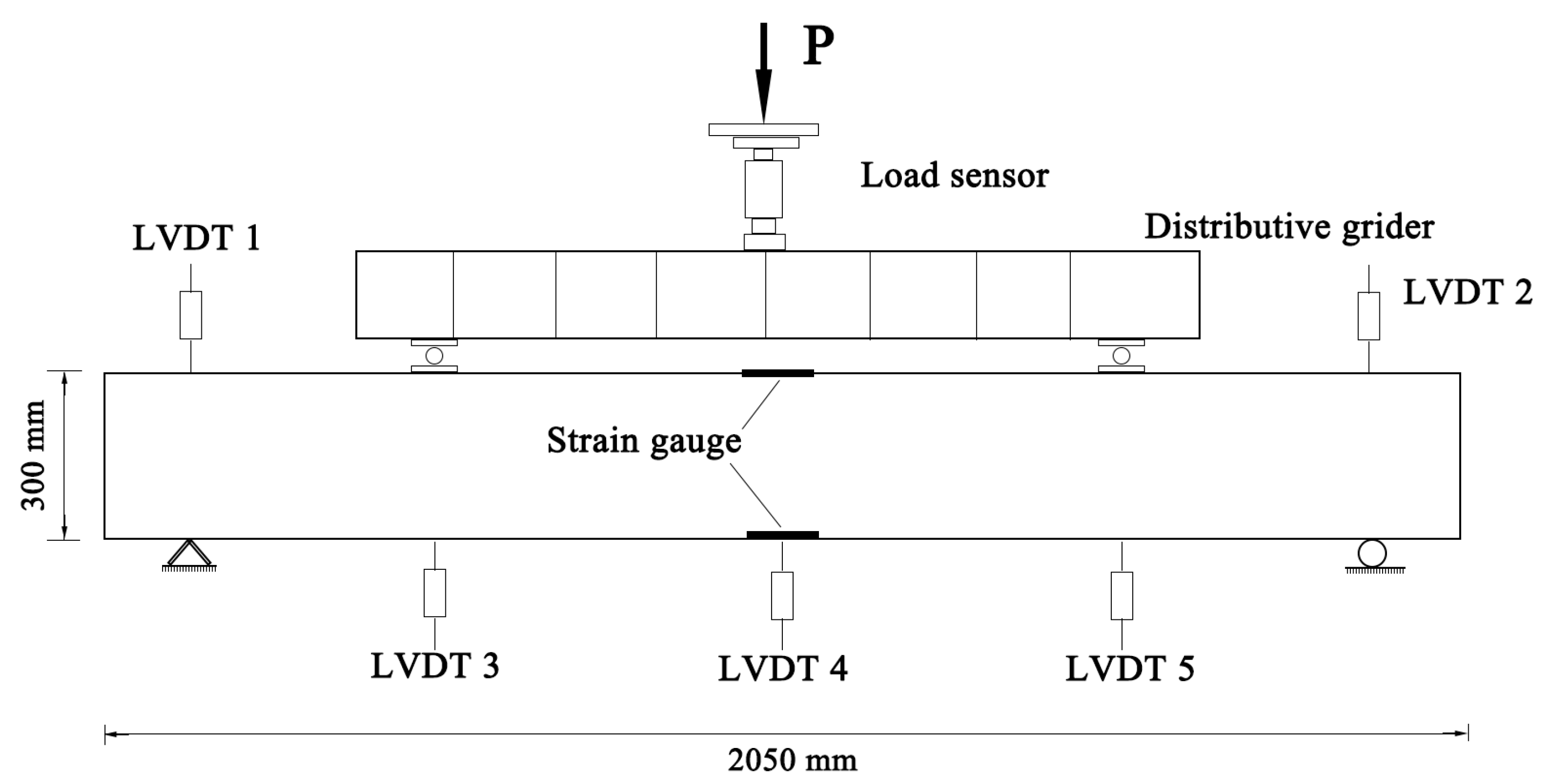
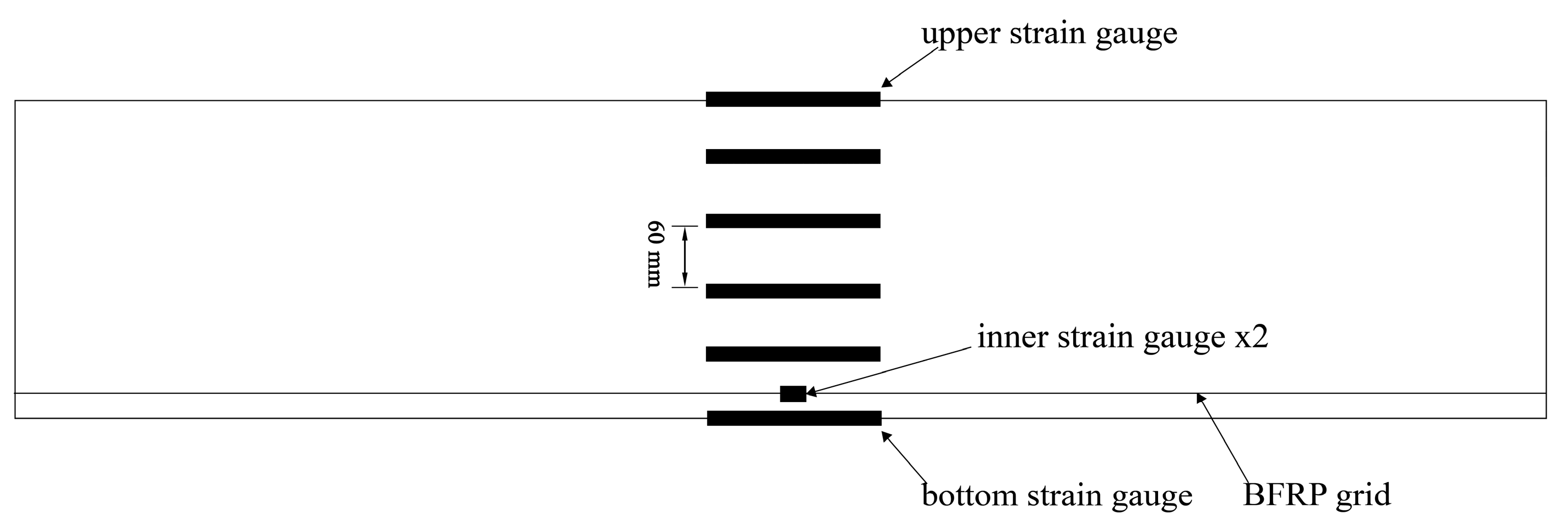
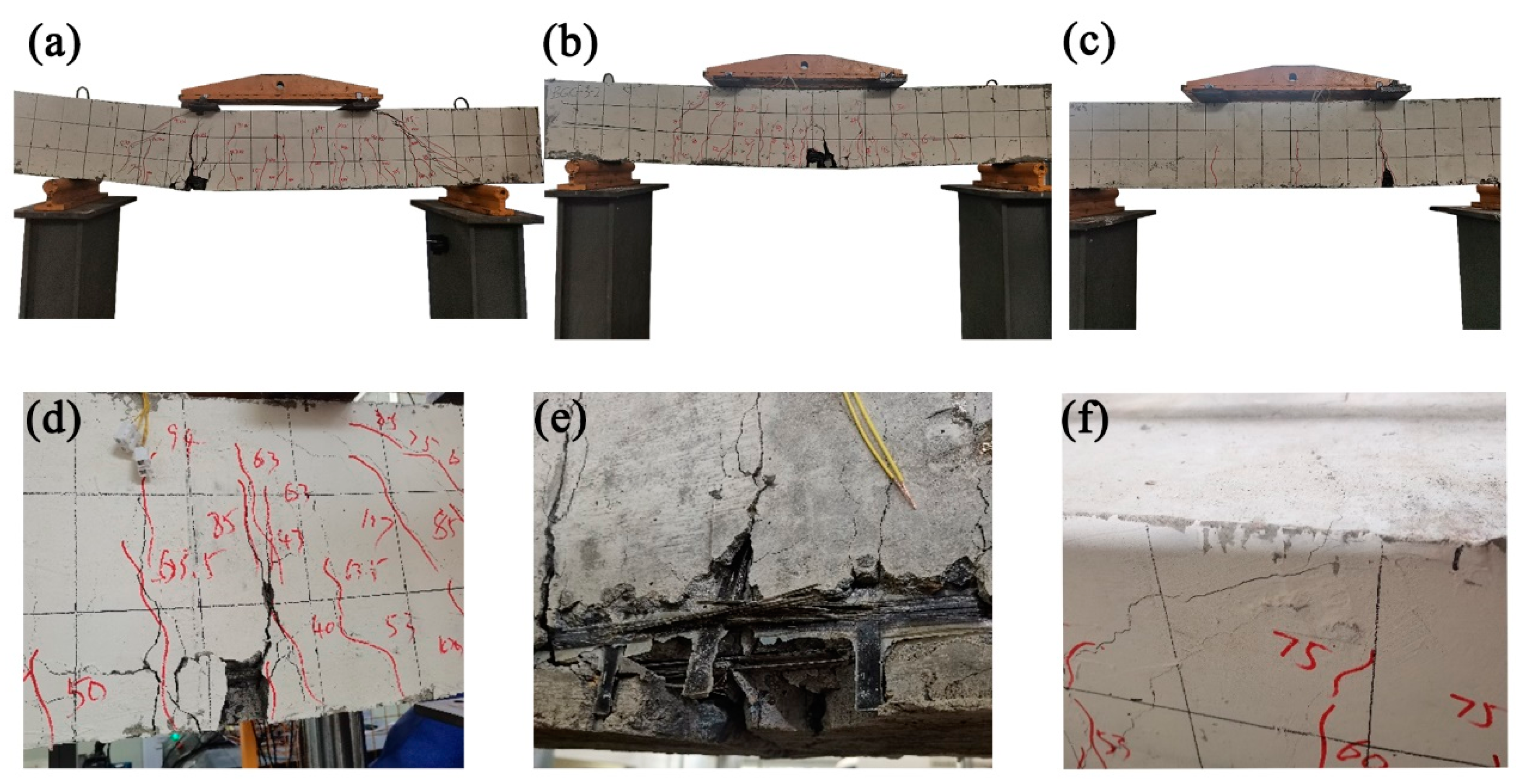

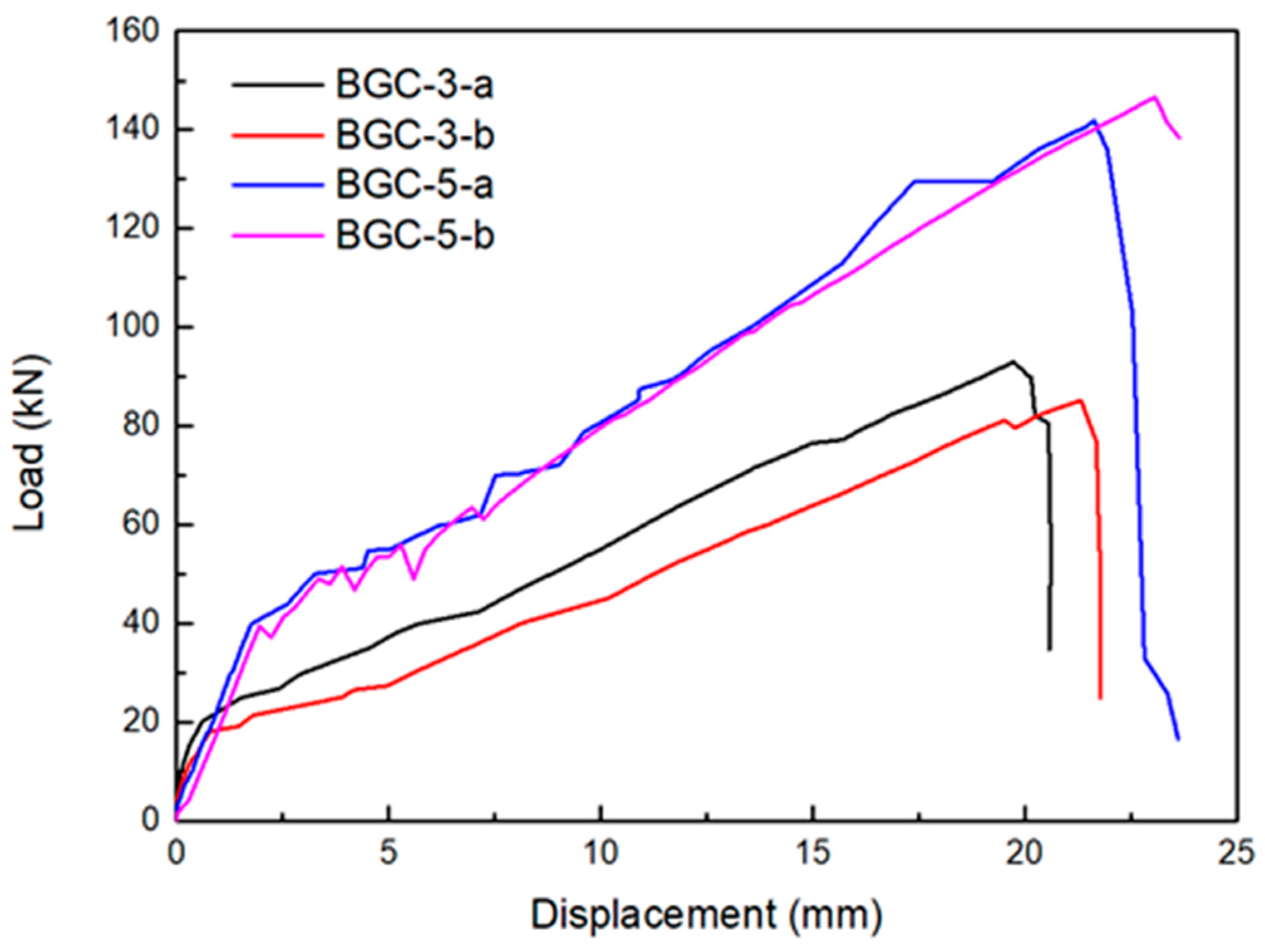
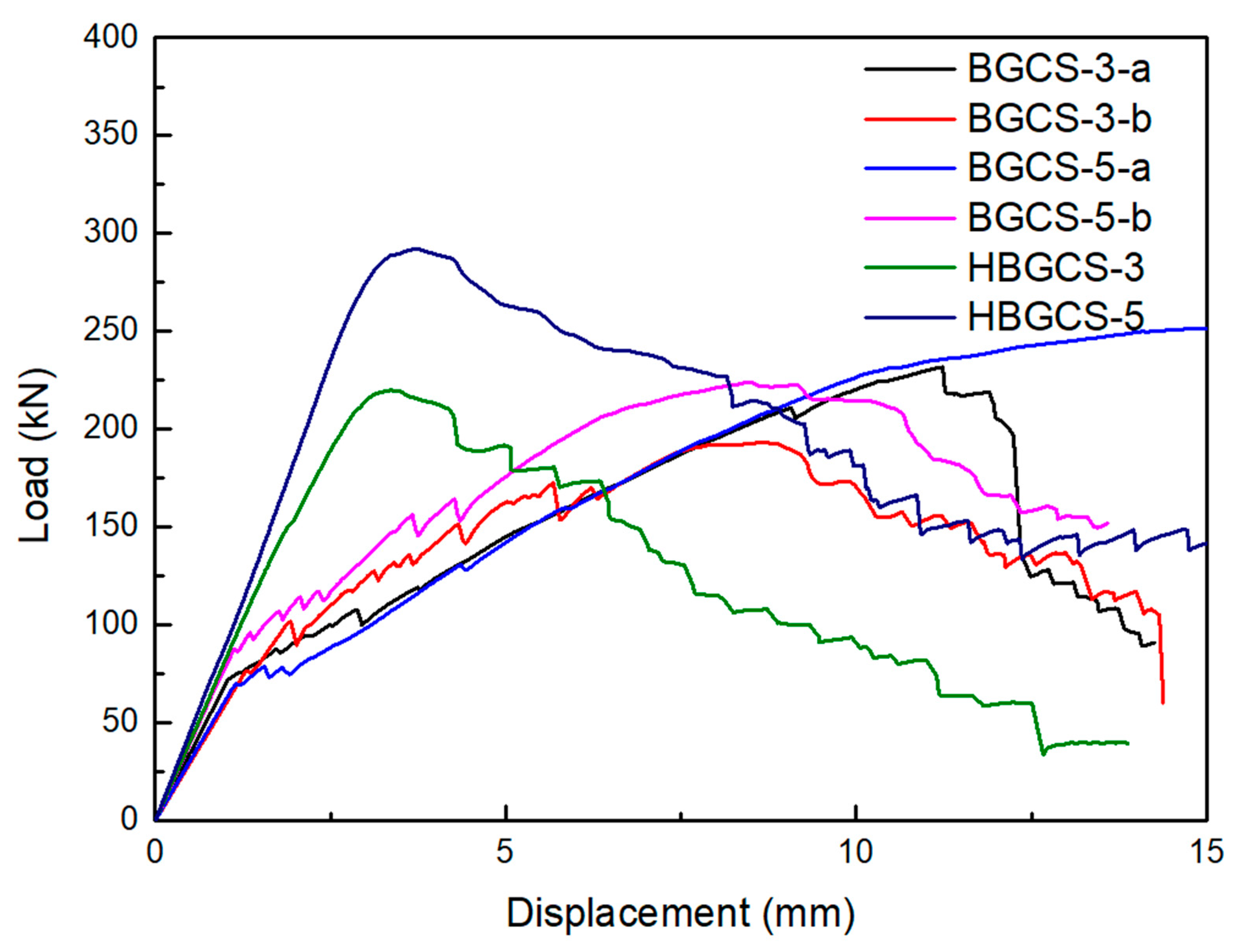
| Specimen Number | Dimensions (mm) | Grid Thickness (mm) | Number |
|---|---|---|---|
| BGC-5-a/b | 200 × 300 × 2050 | 5 | 2 |
| BGC-3-a/b | 200 × 300 × 2050 | 3 | 2 |
| BGC-1-a/b | 200 × 300 × 2050 | 1 | 2 |
| Specimen Number | Shear Span Ratio | Side Grid Thickness | Bottom Grid/Bar |
|---|---|---|---|
| BGCS-3-a | 0.8 | 3 mm | 9 mm grid |
| BGCS-5-a | 0.8 | 5 mm | 9 mm grid |
| BGCS-3-b | 1.16 | 3 mm | 9 mm grid |
| BGCS-5-b | 1.16 | 5 mm | 9 mm grid |
| HGBCS-3 | 1.16 | 3 mm | 18 mm HRB400 |
| HGBCS-5 | 1.16 | 5 mm | 18 mm HRB400 |
| Specimen Number | Concrete Strength Grade | Cube Compressive Strength fcu (Mpa) | Elastic Modulus Ec (GPa) |
|---|---|---|---|
| A1 | C25 | 27.57 | 30.81 |
| A2 | C25 | 28.42 | 30.22 |
| A3 | C25 | 26.32 | 29.65 |
| Types of Specimens | Tensile Elastic Modulus (Gpa) | Tensile Strength (Mpa) | Elongation at Break (%) |
|---|---|---|---|
| 1 mm | 51 | 357 | 0.27 |
| 3 mm | 53 | 386 | 0.26 |
| 5 mm | 57 | 416 | 0.22 |
| Specimen Number | Ny (kN) | Nu (kN) | ΣNu/2 (kN) |
|---|---|---|---|
| BGC-5-a | 40.11 | 141.91 | |
| BGC-5-b | 41.26 | 146.63 | 144.27 |
| BGC-3-a | 27.16 | 93.01 | |
| BGC-3-b | 25.21 | 85.22 | 89.12 |
| BGC-1-a | 20.11 | / | |
| BGC-1-b | 21.83 | / | / |
| Specimen Number | Cracking Load (kN) | Ultimate Load (kN) | Deflection (mm) | Shear Span Ratio |
|---|---|---|---|---|
| BGCS-3-a | 83.3 | 230.13 | 14.25 | 0.8 |
| BGCS-3-b | 60.2 | 193.25 | 14.40 | 1.16 |
| BGCS-5-a | 79.1 | 251.93 | 15.59 | 0.8 |
| BGCS-5-b | 80.2 | 224.07 | 14.48 | 1.16 |
| HBGCS-3 | 210 | 220.24 | 13.90 | 0.8 |
| HBGCS-5 | 285 | 291.78 | 15.52 | 0.8 |
| Specimen Number | Section Size (mm) | Grid Thickness (mm) | Reinforcement Ratio |
|---|---|---|---|
| BGC-5-a/b | 200 × 300 | 5 | 0.5771% |
| BGC-3-a/b | 200 × 300 | 3 | 0.3461% |
| BGC-1-a/b | 200 × 300 | 1 | 0.1153% |
| Specimen Number | Test Value/kN | Calculated Value/kN | Test Value/ Calculated Value |
|---|---|---|---|
| BGC-5-a | 141.91 | 123.74 | 0.87 |
| BGC-5-b | 146.63 | 123.74 | 0.84 |
| BGC-3-a | 93.01 | 74.24 | 0.80 |
| BGC-3-b | 85.22 | 74.24 | 0.87 |
| Specimen Number | Test Value (kN) | ACI (kN) | Test Value/ Calculated Value |
|---|---|---|---|
| BGCS-3-a | 230.13 | 181.58 | 0.79 |
| BGCS-3-b | 193.25 | 181.58 | 0.94 |
| BGCS-5-a | 296.72 | 283.64 | 0.96 |
| BGCS-5-b | 277.55 | 283.64 | 1.02 |
| HBGCS-3 | 220.25 | 214.11 | 0.97 |
| HBGCS-5 | 291.79 | 316.19 | 1.08 |
| Types of Specimens | Tensile Elastic Modulus (Gpa) | Tensile Strength (Mpa) | Elongation at Break (%) |
|---|---|---|---|
| BFRP grid | 51 | 357 | 0.27 |
Disclaimer/Publisher’s Note: The statements, opinions and data contained in all publications are solely those of the individual author(s) and contributor(s) and not of MDPI and/or the editor(s). MDPI and/or the editor(s) disclaim responsibility for any injury to people or property resulting from any ideas, methods, instructions or products referred to in the content. |
© 2024 by the authors. Licensee MDPI, Basel, Switzerland. This article is an open access article distributed under the terms and conditions of the Creative Commons Attribution (CC BY) license (https://creativecommons.org/licenses/by/4.0/).
Share and Cite
Li, H.; Qi, Y.; Li, Y.; Bao, S.; Song, Z. Study of the Mechanical Performance of Grid-Reinforced Concrete Beams with Basalt Fiber-Reinforced Polymers. Appl. Sci. 2024, 14, 1099. https://doi.org/10.3390/app14031099
Li H, Qi Y, Li Y, Bao S, Song Z. Study of the Mechanical Performance of Grid-Reinforced Concrete Beams with Basalt Fiber-Reinforced Polymers. Applied Sciences. 2024; 14(3):1099. https://doi.org/10.3390/app14031099
Chicago/Turabian StyleLi, Haoran, Yujun Qi, Yifei Li, Sai Bao, and Zhongzheng Song. 2024. "Study of the Mechanical Performance of Grid-Reinforced Concrete Beams with Basalt Fiber-Reinforced Polymers" Applied Sciences 14, no. 3: 1099. https://doi.org/10.3390/app14031099
APA StyleLi, H., Qi, Y., Li, Y., Bao, S., & Song, Z. (2024). Study of the Mechanical Performance of Grid-Reinforced Concrete Beams with Basalt Fiber-Reinforced Polymers. Applied Sciences, 14(3), 1099. https://doi.org/10.3390/app14031099




